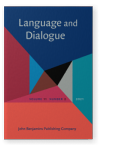Vol. 11:2 (2021) ► pp.173–199
Text operators as dialogical mechanisms in judgments of the French Court of Cassation
The aim of this article is to present text markers as a dialogical mechanism in the French language used in a legal setting. The dialogue between the court and the public administration takes place primarily through a judgment’s justification. On the other hand, the dialogue between the authorities and the court takes place in two possible variants: as a response to the parties allegations raised in the complaint or cassation complaint or as arguments formulated in the cassation complaint. Analyzing the decisions issued by the French Cour de cassation, one may notice that this material is characterized by three aspects: intentional, conventional and institutional, as it refers to a set of established beliefs about the nature of the world of a given community.
Article outline
- 1.Introduction
- 2.Judgment as a genre
- 3.Dialogicality of Court judgments
- 4.Corpus
- 5.Text operators
- 5.1Text operators – content operators
- 5.2Text operators – Truth modal expressions
- 5.3Text operators – Enhancer operators
- 5.4Text operators – Emotional-evaluating and valuing operators
- 5.5Text operators – Mentality operators
- 5.6Text operators – In-text operators
- 6.Conclusions
-
References -
Corpus
